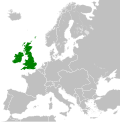United Kingdom of Great Britain and Ireland
The United Kingdom of Great Britain and Ireland was the formal name of the United Kingdom from 1 January 1801 until 12 April 1927. The United Kingdom was formed by the merger of the Kingdom of Great Britain (itself a merger of the Kingdoms of England and Scotland) and the Kingdom of Ireland. Its name was changed in 1927 after the majority of Ireland left the UK in 1922 and became the sovereign Irish Free State, thus leaving only six counties in the north within the UK.
United Kingdom of Great Britain and Ireland | |||||||||||||
|---|---|---|---|---|---|---|---|---|---|---|---|---|---|
| 1801–1922 | |||||||||||||
| Motto: | |||||||||||||
| Anthem: | |||||||||||||
 Territory of the United Kingdom of Great Britain and Ireland until 1922 | |||||||||||||
| Capital | London | ||||||||||||
| Common languages | English³ | ||||||||||||
| Government | Constitutional monarchy | ||||||||||||
| Monarch | |||||||||||||
• 1801–1820 | George III | ||||||||||||
• 1820–1830 | George IV | ||||||||||||
• 1830–1837 | William IV | ||||||||||||
• 1837–1901 | Victoria | ||||||||||||
• 1901–1910 | Edward VII | ||||||||||||
• 1910–1927 (cont.) | George V | ||||||||||||
| Prime Minister | |||||||||||||
• 1801–1801 | William Pitt the Younger | ||||||||||||
• 1924–1927 (cont.) | Stanley Baldwin | ||||||||||||
| Legislature | Parliament | ||||||||||||
| House of Lords | |||||||||||||
| House of Commons | |||||||||||||
| History | |||||||||||||
• | 1 January 1801 | ||||||||||||
| 6 December 1922 | |||||||||||||
• | 12 April 1927 | ||||||||||||
| Area | |||||||||||||
| 1801 | 315,093 km2 (121,658 sq mi) | ||||||||||||
| 1927 | 315,093 km2 (121,658 sq mi) | ||||||||||||
| Population | |||||||||||||
• 1801 | 16345646 | ||||||||||||
• 1927 | 42769196 | ||||||||||||
| Currency | Pound sterling | ||||||||||||
| ISO 3166 code | GB | ||||||||||||
| |||||||||||||
1 The Irish Free State seceded from the United Kingdom in 1922 as a result of the Anglo-Irish Treaty, but this fact was not reflected in the long-form name of United Kingdom until Royal and Parliamentary Titles Act in 1927. The current British state, the United Kingdom of Great Britain and Northern Ireland, is universally accepted to be a direct continuation of the United Kingdom of Great Britain and Ireland, and should not be imagined to be a break from it or a new state formed after it. ² The Royal motto used in Scotland was Nemo Me Impune Lacessit (Latin for "No-one provokes me with impunity"). ³ In addition to English (official status established by precedent), Irish, Scottish Gaelic, and Welsh were spoken regionally. | |||||||||||||
List of monarchs
The monarch continued to use the title of King or Queen of United Kingdom of Great Britain and Ireland until 1927.
House of Hanover
- George III (1801–1820) (monarch from 1760)
- George IV (1820–1830)
- William IV (1830–1837)
- Victoria (1837–1901)
- House of Saxe-Coburg and Gotha
- Edward VII (1901–1910)
- House of Windsor (as of 1914)
- George V (1910–1922) (title used until 1927)
United Kingdom Of Great Britain And Ireland Media
God Save the King - Alan Turner
The signing of the Treaty of Ghent ending the war with the United States(by Amédée Forestier, c. 1915)
The Peterloo Massacre of 1819 resulted in 18 deaths and several hundred injured.
Lord Palmerston addressing the House of Commons during the debates on the Treaty of France, February 1860
Jeremy Bentham's panopticon prison (1791 drawing by Willey Reveley)
Related pages
Other websites
- British History Online
- Act of Union 1800 Archived 2007-05-05 at the Wayback Machine
| Preceded by: United Kingdom of Great Britain 1707–1801 Kingdom of Ireland 1541–1801 |
United Kingdom of Great Britain and Ireland 1801–1927 |
Succeeded by: United Kingdom of Great Britain and Northern Ireland 1927–present Irish Free State 1922–1937 |






